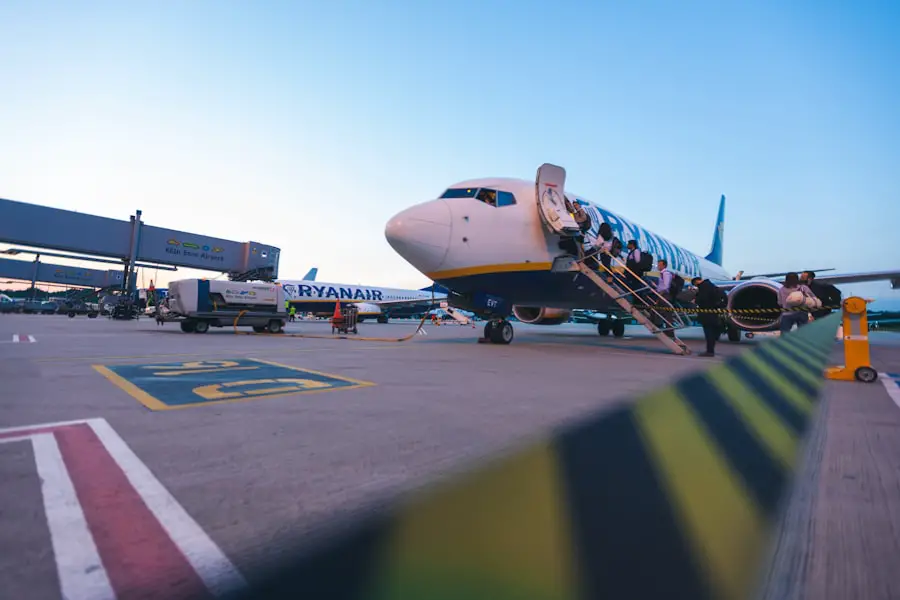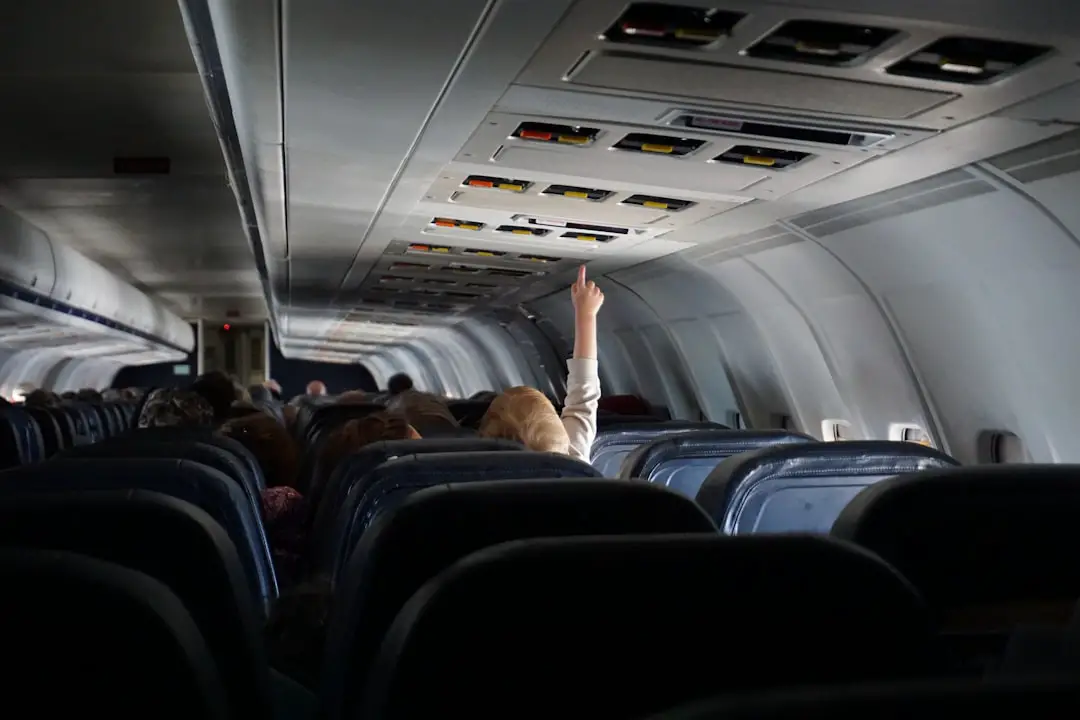PSA Airlines, a regional airline based in the United States, operates as a wholly-owned subsidiary of American Airlines Group. Established in 1970, the airline has grown significantly over the decades, providing essential air travel services primarily in the eastern and midwestern regions of the United States. With its headquarters in Dayton, Ohio, PSA Airlines plays a crucial role in American Airlines’ regional operations, serving as a feeder airline that connects smaller markets to larger hubs.
The airline operates a fleet predominantly composed of Bombardier CRJ regional jets, which are known for their efficiency and suitability for short-haul flights. The airline’s operational model is designed to enhance connectivity for passengers traveling to major destinations while maintaining a focus on customer service and operational efficiency. PSA Airlines operates under the American Eagle brand, which is synonymous with regional air travel in the U.S.
This affiliation allows PSA to leverage American Airlines’ extensive network, providing passengers with seamless travel options and access to a wide range of destinations. As a regional carrier, PSA Airlines is integral to the broader American Airlines system, ensuring that even smaller communities have access to air travel.
Key Takeaways
- PSA Airlines is a regional airline operating under American Airlines, providing service to over 90 destinations in the United States, Canada, and the Bahamas.
- The airline adheres to strict safety regulations and standards set by the Federal Aviation Administration (FAA) and undergoes regular safety audits to ensure compliance.
- PSA Airlines requires its pilots to undergo rigorous training and have a minimum amount of flight experience before being allowed to operate commercial flights.
- The airline prioritizes aircraft maintenance and inspections to ensure the safety and airworthiness of its fleet.
- Despite a few incidents in its history, PSA Airlines has a relatively good safety record and has implemented emergency procedures and protocols to handle any potential issues that may arise during flights.
Safety Regulations and Standards
Compliance with Regulations
Airlines is committed to maintaining compliance with these regulations, designed to minimize risks and enhance passenger safety. In addition to FAA regulations, PSA Airlines also follows the safety standards established by the American Airlines Group, which includes rigorous internal audits and safety assessments that evaluate every aspect of the airline’s operations.
Safety Management System
PSA Airlines’ safety management system (SMS) is a proactive approach that identifies potential hazards and implements measures to mitigate risks before they can impact flight safety. By fostering a culture of safety and accountability, PSA Airlines ensures that its operations meet or exceed industry standards, thereby instilling confidence in its passengers.
A Culture of Safety
By prioritizing safety, PSA Airlines creates a culture of accountability, ensuring that its operations meet or exceed industry standards, giving passengers peace of mind.
Pilot Training and Experience

The training and experience of pilots are critical components of aviation safety, and PSA Airlines places a strong emphasis on developing highly skilled pilots. The airline’s training program is comprehensive, encompassing both ground school instruction and extensive flight training. New pilots undergo rigorous training that includes simulator sessions, where they practice handling various flight scenarios, including emergency situations.
This training is designed to prepare pilots for real-world challenges they may encounter during their careers. Moreover, PSA Airlines requires its pilots to have a minimum number of flight hours before they can operate commercial flights. This requirement ensures that pilots possess adequate experience and proficiency in flying regional jets.
Additionally, ongoing training is mandatory for all pilots, including recurrent training sessions that keep them updated on new regulations, procedures, and technologies. This commitment to continuous education not only enhances pilot skills but also reinforces the airline’s dedication to maintaining high safety standards.
Aircraft Maintenance and Inspections
| Metrics | 2019 | 2020 | 2021 |
|---|---|---|---|
| Number of Aircraft Inspections | 500 | 550 | 600 |
| Average Maintenance Downtime (hours) | 20 | 18 | 15 |
| Percentage of Scheduled Maintenance Completed | 95% | 97% | 98% |
Aircraft maintenance is a critical aspect of ensuring flight safety, and PSA Airlines adheres to rigorous maintenance protocols for its fleet of Bombardier CRJ jets. The airline follows a strict maintenance schedule that includes regular inspections, preventive maintenance, and repairs as needed. These inspections are conducted in accordance with FAA regulations and manufacturer guidelines, ensuring that each aircraft is in optimal condition before it takes to the skies.
PSA Airlines employs a team of qualified maintenance personnel who are trained to perform detailed inspections and repairs on the aircraft. This team conducts routine checks on various aircraft systems, including engines, avionics, and structural components. In addition to scheduled maintenance, the airline also conducts unscheduled inspections in response to any anomalies or concerns raised by pilots or crew members during flight operations.
This proactive approach to maintenance helps identify potential issues before they escalate, thereby enhancing overall safety.
Safety Record and Incidents
When evaluating an airline’s safety profile, it is essential to consider its safety record and any incidents that may have occurred throughout its operational history. PSA Airlines has maintained a commendable safety record over the years, with no fatal accidents reported since it became a regional carrier under the American Eagle brand. This impressive track record reflects the airline’s commitment to adhering to safety regulations and implementing best practices in aviation safety.
While no airline is entirely free from incidents, PSA Airlines has demonstrated an ability to manage and respond effectively to challenges. The airline has experienced minor incidents over the years; however, these occurrences have been addressed promptly and transparently. Investigations into any incidents are conducted thoroughly, with findings used to improve operational procedures and enhance safety measures.
This commitment to learning from past experiences contributes to the airline’s ongoing efforts to maintain a high level of safety for its passengers.
Emergency Procedures and Protocols

In aviation, preparedness for emergencies is crucial for ensuring passenger safety. PSA Airlines has established comprehensive emergency procedures and protocols that are regularly reviewed and practiced by its flight crews. These procedures cover a wide range of potential scenarios, including cabin depressurization, engine failure, medical emergencies, and evacuation procedures.
By training pilots and crew members on these protocols, PSA ensures that they are well-equipped to handle emergencies should they arise. Regular drills and simulations are conducted to reinforce these emergency procedures among flight crews. These exercises allow crew members to practice their responses in a controlled environment, ensuring that they can act swiftly and effectively during real emergencies.
Additionally, passengers are briefed on safety procedures before each flight, including the location of emergency exits and the use of life vests. This emphasis on preparedness fosters a culture of safety within the airline and helps instill confidence in passengers regarding their well-being during flights.
Passenger Feedback and Reviews
Passenger feedback plays an essential role in assessing an airline’s performance and overall safety culture. PSA Airlines actively seeks input from its customers through various channels, including post-flight surveys and online reviews. This feedback provides valuable insights into passengers’ experiences regarding service quality, comfort, and perceived safety during their flights.
By analyzing this information, PSA can identify areas for improvement and make necessary adjustments to enhance the overall travel experience. Reviews from passengers often highlight aspects such as cabin cleanliness, crew professionalism, and on-time performance as critical factors influencing their perception of safety. Positive feedback regarding these elements can contribute to an overall sense of security among travelers.
Conversely, any negative feedback is taken seriously by the airline’s management team, prompting investigations into specific concerns raised by passengers. This commitment to listening to customer feedback demonstrates PSA Airlines’ dedication to continuous improvement in all aspects of its operations.
Is PSA Airlines Safe for Passengers?
In evaluating whether PSA Airlines is safe for passengers, it becomes evident that the airline prioritizes safety through rigorous adherence to regulations, comprehensive pilot training programs, meticulous aircraft maintenance practices, and effective emergency protocols. The absence of fatal accidents in its recent history further underscores its commitment to maintaining high safety standards. While no airline can guarantee absolute safety due to the inherent risks associated with aviation, PSA Airlines has established a robust framework designed to mitigate these risks effectively.
Ultimately, passenger perceptions of safety are influenced by various factors, including personal experiences and feedback from fellow travelers. By fostering a culture of transparency and responsiveness to customer concerns, PSA Airlines continues to build trust among its passengers. As travelers consider their options for air travel within the United States, understanding the measures taken by airlines like PSA can provide reassurance regarding their safety while flying with this regional carrier.
When considering the safety of PSA Airlines, it is important to also take into account the overall travel experience. Noise-canceling earbuds can enhance your comfort and enjoyment during your flight. TakeTravelInfo has a list of 5 wired noise-canceling earbuds perfect for your next flight, which can help you relax and unwind while in the air. By investing in quality earbuds, you can create a more pleasant travel experience with PSA Airlines. Check out the article here for more information.
FAQs
Is PSA Airlines a safe airline to fly with?
PSA Airlines has a strong safety record and is considered a safe airline to fly with. It is a subsidiary of American Airlines and operates under the same safety standards.
What safety measures does PSA Airlines have in place?
PSA Airlines adheres to all Federal Aviation Administration (FAA) regulations and undergoes regular safety inspections. The airline also has a comprehensive safety management system in place to identify and mitigate potential risks.
Has PSA Airlines had any major safety incidents in the past?
PSA Airlines has had a few minor incidents in the past, but no major safety incidents that have resulted in significant injuries or fatalities. The airline has a strong safety culture and continuously works to improve its safety standards.
How does PSA Airlines compare to other airlines in terms of safety?
PSA Airlines is on par with other major airlines in terms of safety. It operates under the same safety regulations and standards as its parent company, American Airlines, and is subject to the same rigorous safety oversight.
What should passengers do to ensure their safety when flying with PSA Airlines?
Passengers can ensure their safety when flying with PSA Airlines by following all safety instructions provided by the airline staff, fastening their seatbelts during the flight, and paying attention to the pre-flight safety briefing. It is also important to report any safety concerns to the airline staff.
